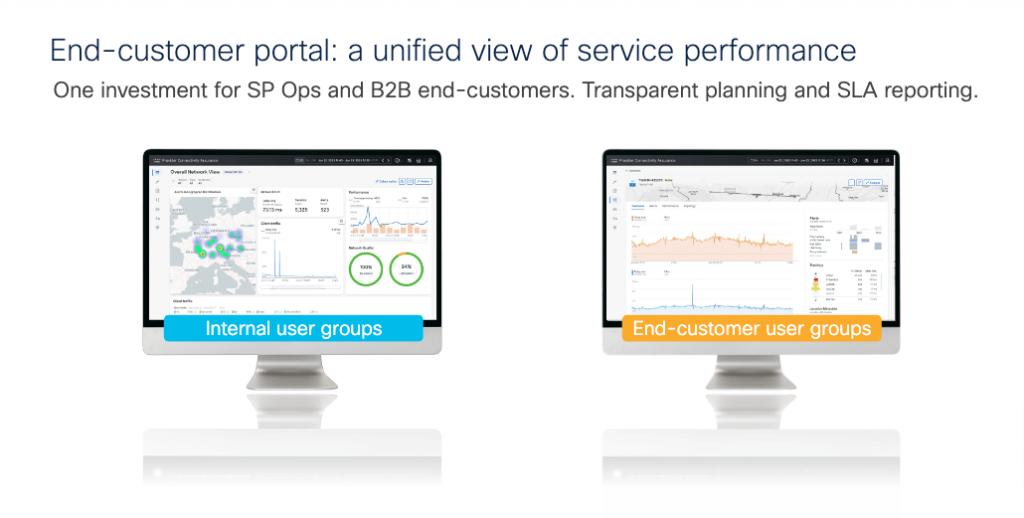Communications service providers (CSPs) are starting to think about service assurance in a new light, recognizing—and reaping—value from the technology beyond its baseline capacity to support performance monitoring and assurance.
By using high-quality performance data from the same set of assurance sensors or probes, but making the insights more accessible to different internal and external user personas in a fully customizable and secure way, providers can differentiate their services and create new revenue opportunities.
If your service assurance solution provides the control and visibility required to ensure high-performing connectivity, that means you have everything you need to deliver innovative services faster, more reliably, with greater agility—and at a premium.
Here are four revenue-driving initiatives you should look to capitalize on:
1. Deliver competitive SLA-backed services.
A network service-level agreement (SLA) that is supported by evidence can attract a premium recurring revenue stream while also differentiating the service provider in a competitive market.
At the same time, enterprise customers are demanding things be delivered faster, with 100% reliability and digital resilience. High quality of service (Hi-QoS) distinguishes the new wave of services that support their businesses, from high-performance SD-WANs and real-time manufacturing and drone controls to high-speed, low-latency trading network services.
Assurance gives CSPs the confidence to offer stringent performance SLAs irrespective of the network connectivity delivering the service. This is achieved by coupling provider-grade active monitoring or probing techniques with powerful automation capabilities for performing remediation and change—all with the goal of maintaining individual service-level objectives for each key performance indicator (KPI) or for a combined SLA.
2. Upsell performance reporting with end-customer portals.
SLA-backed services can be offered together with an end-customer portal. End-customer portals represent a significant opportunity for upselling and differentiation of premium services. In just a few mouse clicks, an admin can easily package a cloud-native, multi-tenanted portal capability that is secure and fully customizable for an end customer user group.
This gives the end customer a sense of control and ownership that breeds a culture of trust and transparency with their service provider. Over time, this results in many other tangential benefits for both parties, such as unlocking further upsell potential through capacity upgrades or re-engineering of service routing to achieve more stringent SLAs. It really is a true win-win scenario that many of our existing customers are already leveraging.

For example, Colt recently deployed the reporting and analytics component of Cisco Provider Connectivity Assurance—not only for use by internal teams across 10 different personas, but also for selected premium end customers in the form of customer portals. This differentiated offering has made Colt more competitive in requests for proposals (RFPs), while supporting an estimated 25% churn reduction due to the stickiness of the portal customer experience. In addition, detailed usage and performance information provided through this portal has led the European CSP’s business customers to add 30% more capacity to their Hi-QoS service mix.
This is extremely powerful in terms of customer experience. It helps to avoid tickets as customers can see for themselves what happened with their service. This reduces tension and increases customer satisfaction.
Bart Janssens – Senior Specialist Packet Architect, Colt Technology Services
3. Offer contextual alerting as a proactive value add.
Contextual alerts are messages generated by a service assurance solution that are exposed to the CSP’s end customers. These messages can be used to trigger a wide range of manual or automated actions within the end customer’s organization, such as predicted capacity exhaustion or a performance issue. In these examples, an end customer may request a capacity upgrade or query why specific KPIs aren’t as expected.
Contextual alerts are often delivered via an end-customer portal, but can be catered for almost any mechanism a customer requests—message queuing telemetry transport (MQTT) bus, simple network management protocol (SNMP), email, or fed directly to ServiceNow.
AT&T Business, for instance, offers customers the option to receive filtered real-time alerts for selected performance threshold crossings, available via email, text, and other formats. This mitigates against any performance degradation in their applications. Customers can specify automated actions in the AT&T Policy Engine to be taken when threshold crossings occur. An automated trouble ticket is also created and forwarded to the AT&T technicians. Watch this webinar on how AT&T benefits by using service-centric assurance.
Contextual alerting provides the kind of visibility into the SD-WAN managed service performance that customers have sought as their enterprise connectivity services have become a critical part of their business infrastructure. Enterprises can take control of their network service performance and engage in more meaningful conversations with their provider account managers, and the provider can charge a premium for delivering proactive alerting.
4. Send informational notifications for provider sales teams.
While closely linked to contextual alerting, informal notifications support different use cases. Any notification that guides network service provider teams toward customers who need additional capacity is of interest. By using a combination of static and dynamic thresholds, combined with trending and predictive AI capabilities, sales teams receive an early indication regarding when to pick up the phone to their customers and engage in a proactive discussion about capacity upgrades.
The same idea can be applied to specific performance indicators, such as latency, packet loss, or power usage. It could be the case that as traffic volumes increase, latency starts to drift outside of the acceptable range of a low-latency network service. This could be the trigger for sales to discuss options to move the traffic to a different route or to a premium class of service across the network.
All these examples share a common theme: By leveraging service assurance solutions, the CSP can be continuously guided toward improving the digital experience for a given customer while generating some additional recurring revenue. For more insights on the economic benefits of this approach, as well as case studies of the companies cited above and more, download the new paper on service-centric assurance from ACG Research.
Share:


